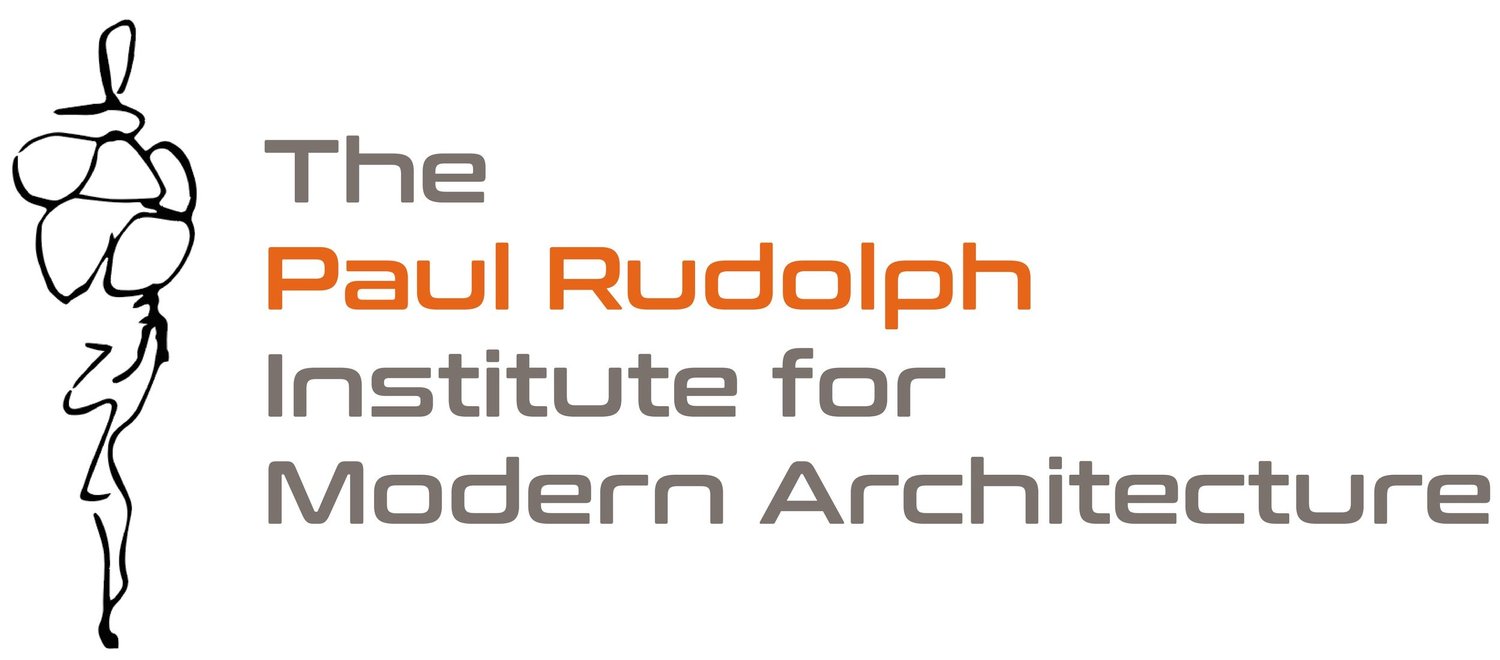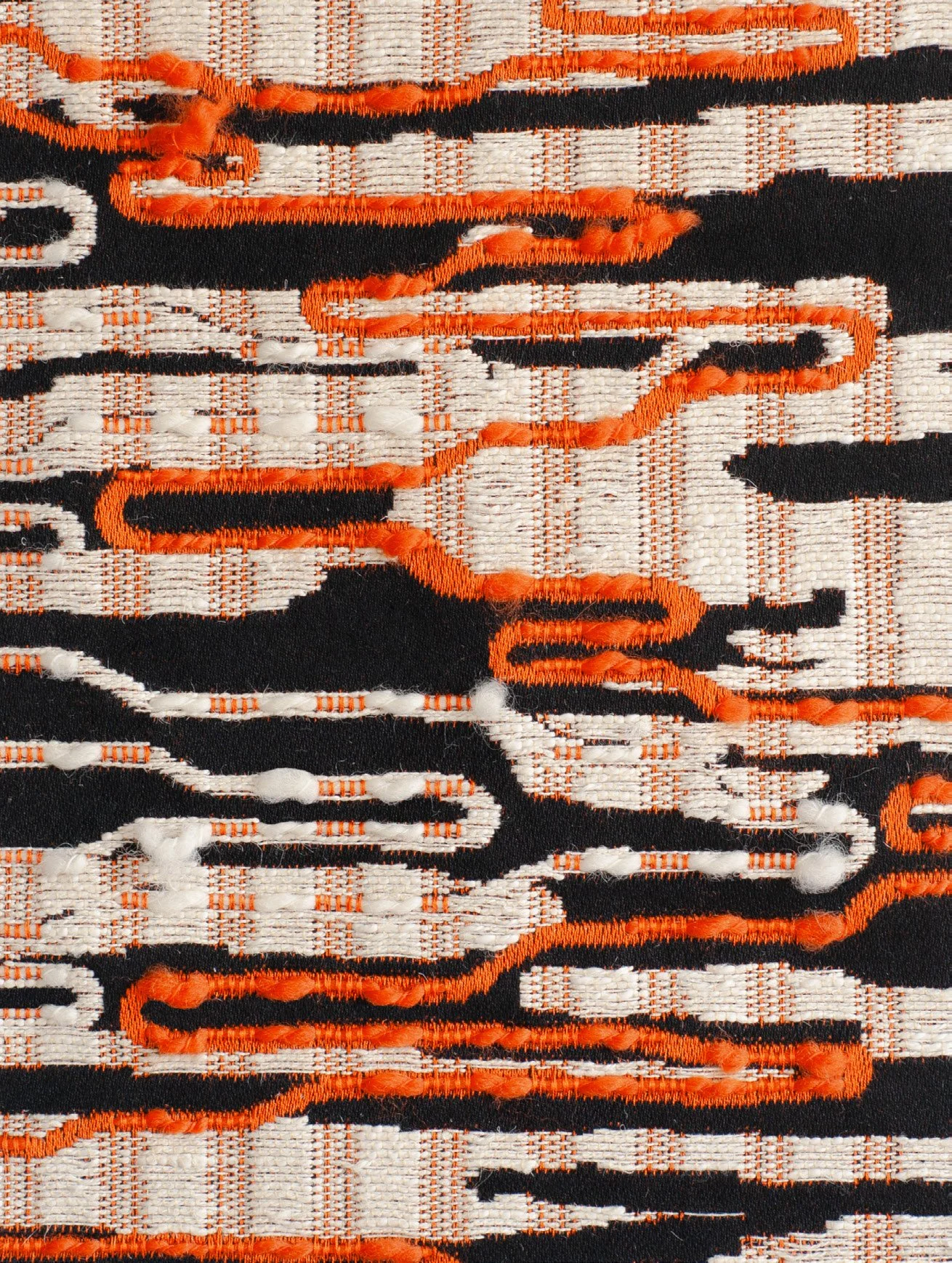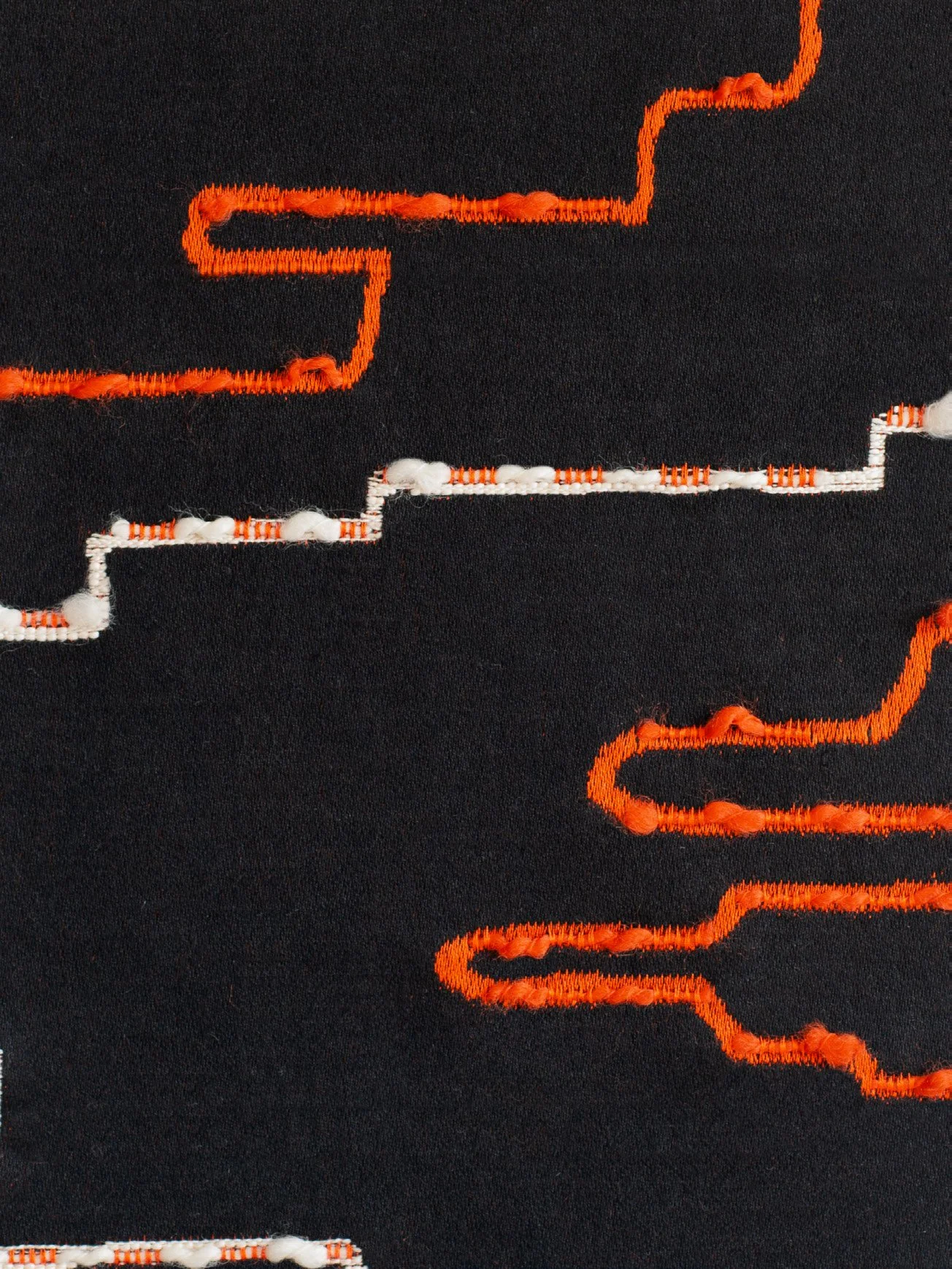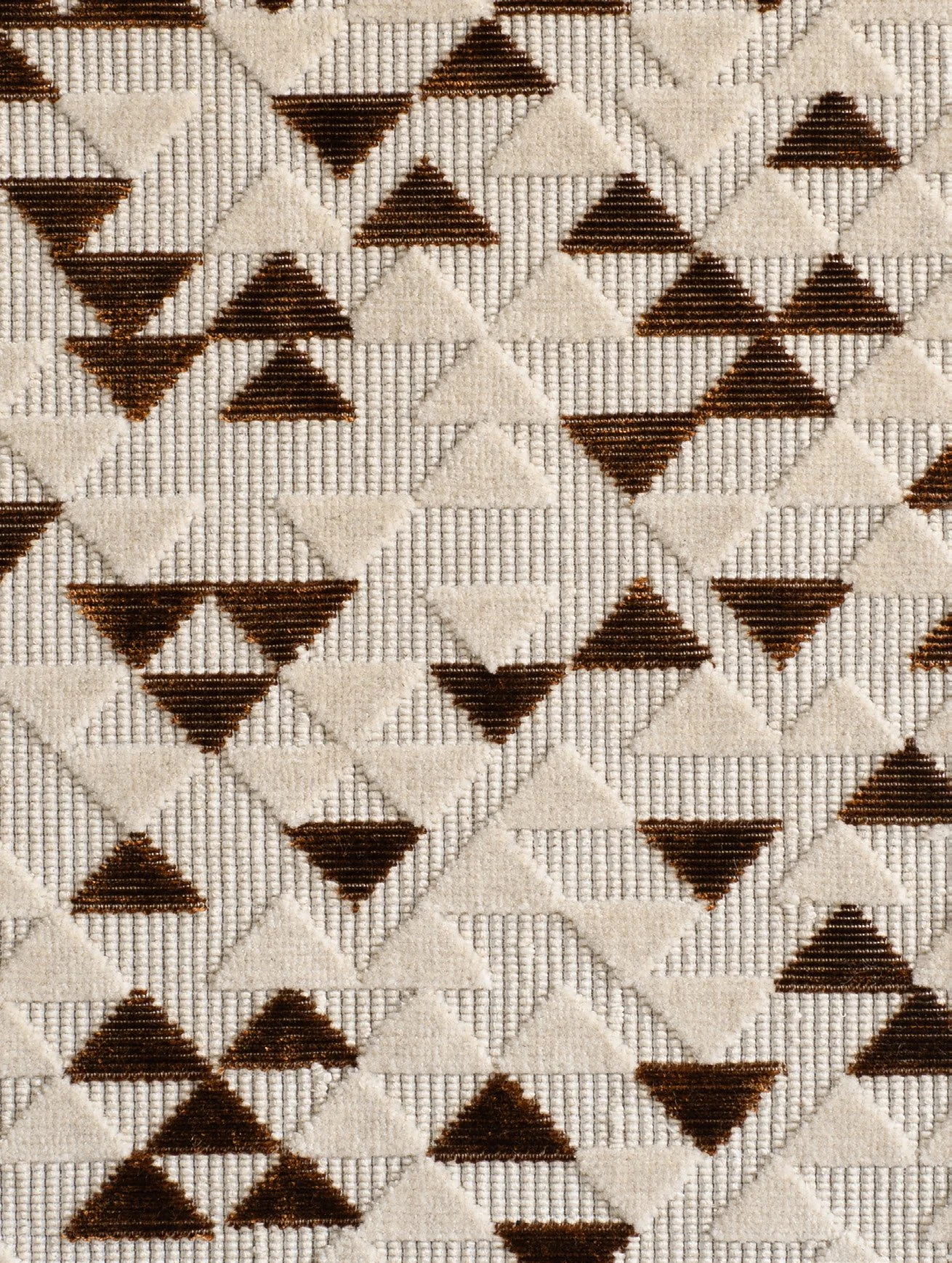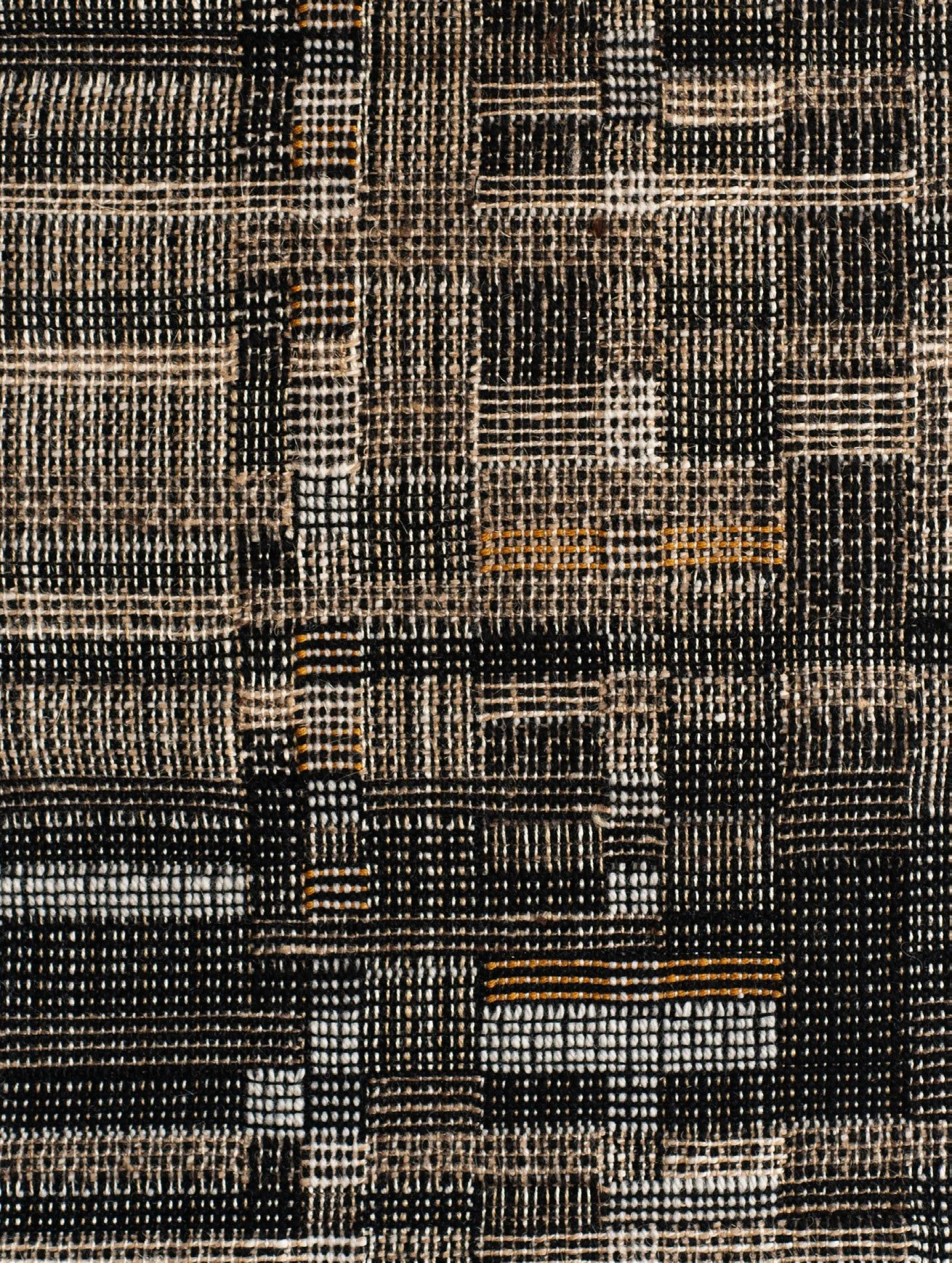WEAVING ANNI ALBERS: Friday, November 07, 2025 - Tuesday, November 11, 2025
UNDER WAY 1963 - Meandering Thread on Composite Weave
1 COL H: 140 CM / 55.1 INCH
COMP GROUND 31% VISCOSE 28% COTTON 19% JUTE 15% WOOL 4% ACRYLIC 3% POLYESTER
A line that “meanders aimlessly” as Albers used to say, quoting Paul Klee, animates several of her works dated 1961-67. In the composite mingling of yarns, weave structures and colours, a randomly cast thread of wool tries to find its way across a cotton fabric of satin and jute weft threads: the pattern it traces is poised somewhere between calligraphy and a stroll. The high gauge ondé yarn worked with the fil coupé technique, the lively colour palette and the artful use of appropriate technical solutions create three-dimensionality on a complex and densely woven ground. Threads are to weaving what paints and brushes are to an artist: tools for creating visual and tactile sensations, they produce an image that lends itself to interpretation in the same way as a painting. The strong textural element recalls all the beauty of hand weaving.
DEDAR BRINGS WEAVING ANNI ALBERS TO PAUL RUDOLPH'S MODULIGHTOR BUILDING
Dedar’s collaboration with The Josef & Anni Albers Foundation arrives in New York, uniting two modernists who transformed their disciplines.
New York, November 2025
Italian textile company Dedar presents Weaving Anni Albers at the Paul Rudolph Institute in New York, pairing textile artist Anni Albers's work with architect Paul Rudolph's building—two contemporaries who moved in overlapping professional worlds during the same midcentury period and advanced modernism toward a new material complexity.
Following installations in Milan, Copenhagen, and Como, this exhibition represents the fourth iteration of Dedar's ongoing collaboration with The Josef & Anni Albers Foundation.
The collection features five jacquard fabrics that translate Albers's original designs from 1936 to 1974 into contemporary production, demanding the textile expertise cultivated by Dedar's decades of research and demonstrating Albers’s conviction that weaving could be both functional craft and artistic expression.
Caterina and Raffaele Fabrizio, CEO and Creative Director of Dedar, experienced a deep sense of wonder while exploring Albers’s works at the Foundation. The exhibition seeks to capture that sense of inspiration, awe and appreciation. “The exploration of Albers’s work and the dialogue with her way of thinking have called for open mindedness in creative terms - and, above all, the desire to ‘take thread for a walk’, without any particular destination in mind, just as Albers did, inspired by the maestro Paul Klee. The reinterpretation of textures, colors, and forms originally intended for hand weaving has put our textile expertise to the test but, as she herself used to say, ‘art gives us courage’ and therefore, with every new research endeavor we expand our knowledge”, say Caterina and Raffaele Fabrizio.
Born in Germany in 1899, Albers entered the Bauhaus in 1922. She married Josef Albers in 1925 and developed her practice under the principle that threads were semantic vehicles. When the Bauhaus closed in 1933, the Alberses emigrated to the United States and joined Black Mountain College's faculty, where Anni produced both functional textiles and "pictorial weavings". Her later travels to Mexico and Peru were pivotal to her understanding of weaving as cultural language. Rudolph trained at Harvard under Walter Gropius, the Bauhaus founder who had taught Josef Albers.
Both practices emerged from Bauhaus principles but pushed beyond early modernist orthodoxy, insisting on texture, complexity, and material presence. Both figures believed that modernism did not necessitate austerity.
Albers elevated weaving to an art form while enriching artistic language by using the loom as a creative tool. Her work embodies both the precision of industrial production and the expressive freedom of unrestricted color, line, and weave.
Rudolph created architecture that engaged with texture and sensory experience. At Yale in the late 1950s and early 1960s, Albers gave guest lectures on textile arts while Rudolph served as Chairman of the Architecture Department.
The Modulightor Building's multiple levels, modulated light, and white geometric surfaces offer an environment in dialogue with the patterns, colors, and textures of the textiles, asserting that these foundational modernists operated according to similar logics of structure, rhythm, and material intelligence.
The setting design by Akari Endo-Gaut is carefully constructed to enhance the fabrics without overshadowing them. Each textile is displayed with the intention of revealing its depth – its interplay of light and shadow, the tactility of its weave, and the modernity inherent in its composition.
“My approach for designing this exhibition was deeply rooted in my desire to weave together three worlds: architecture, the designs of Anni Albers, and the fabrics themselves”, states Akari Endo-Gaut. “I used color structures as the warps and wefts connecting the textiles, with the iconic building by Paul Rudolph functioning as a loom, the fabrics becoming threads that weave the experience together. I envisioned visitors immersing themselves fully in the exhibition. I want them to see the colors, the intricate textures, and to experience not only the visual beauty but also the complex processes behind each textile”.
Visitors are invited to engage with Albers’s works in a setting that highlights the fabrics as the true protagonists. Completing the narrative is a film produced by Dedar and directed by Alessandro Del Vigna.
“It has long been our dream to see Anni Albers' materials reproduced with maximum fidelity to their original appearance. The people at Dedar have done a superlative job of realizing this desire", states Nicholas Fox Weber, Director of The Josef & Anni Albers Foundation. "We feel that Anni would have been thrilled."
The project celebrates the artist’s legacy while embracing her invitation to create and recreate. Weaving Anni Albers is a dialogue across time – the beginning of an ongoing conversation between art, design, and materiality.
Weaving Anni Albers
Paul Rudolph Institute
246 East 58th Street, Manhattan, New York, US
7 November, from 11 AM to 6 PM
8 November, from 2 PM to 6 PM
10-11 November, from 10 AM to 6 PM
Exhibition curated by Stephanie Barth & Carina Frey
Exhibition design by Akari Endo-Gaut
Sound design by Paolo Tocci
Film directed by Alessandro Del Vigna
EN ROUTE - Meandering Line on a Full Ground
1 COL H: 137 CM/53.9 INCH
COMP 42% COTTON 37% VISCOSE 12% WOOL 5% ACRYLIC 4% POLYESTER
The jacquard inspired by Under Way 1963 develops Albers research on yarn as a subject: not just a mere functional element but a bearer of meaning. In this full-grounded version, Dedar affords a protagonist role to the raised effect of the lancé weft. The motif that extends for the entire fabric width, far reaching and variegated in its composition, stands out clearly from the ground; it reconciles graphic purity with the lavish variety of yarns, particularly evident in the selvedge fringes. The curvilinear narration, consisting of an uninterrupted thread, is especially impacting when used for panels, screens, or decorative applications; as a curtain, the fabric drapes softly, to further enhance its beauty.
ANCIENT WRITING 1936 - Zapotec Graduated Geometries
2 COL
COL. 001 H: 132 CM/52 INCH
COMP 79% COTTON 7% SILK 6% POLYESTER - TREVIRA CS - 6% WOOL 2% METALLIC POLYESTER
COL. 002 H: 133 CM/52.4 INCH
COMP 78% COTTON 10% POLYESTER - TREVIRA CS - 6% WOOL 4% POLYESTER 2% VISCOSE
The inspiration that Albers drew, as a keen traveler, from the Native American cultures, leaves its unmistakable mark here. The motif is permeated with all the magic of a visit to the Zapotec site of Monte Albán, in Mexico: warmth and archaic echoes mitigate the modern rigor of geometric motifs. Six weft threads are alternated. Of the graduated effect, some lines are clearly visible while others barely emerge from the dark context (as in the original) or from the ivory shades of the light colored variant. An unfaltering textile expertise has perfectly rendered the different chromatic and textural depths of the hand-woven artifact, also thanks to inserts, fil coupé and an attentive choice of materials.
DRAWING XVI (B) 1974 - Rhythmic Nuances on Jacquard Velvet
3 COL H: 139 CM / 54.7 INCH
COMP 45% COTTON 35% VISCOSE 12% POLYESTER 8% LINEN
Triangles animate various designs by Albers, who translated them into an irregular quality, a reciprocal penetration of rhythm and a shunning of repetition. “DR XVI (B)”, a project she expressed exclusively on paper, now provides a cue to confer a new dimension to her artistic work — which, until today, had never generated a velvet. The curly textural fabric with vertical evolution contrasts with the softness of the velvet pile: the white variant, which is dense, matt, and cottony, and the colored one with its silky look.
UNTITLED 1948 - Light and Shade on a Modernist Damier Motif
3 COL H: 134 CM / 52.8 INCH
COMP COL. 001 38% WOOL 30% VISCOSE 10% POLYAMIDE 9% JUTE 9% COTTON 3% OTHER FIBERS 1% SILK
COL. 002,003 37% WOOL 30% VISCOSE 10% POLYAMIDE 9% JUTE 9% COTTON 4% OTHER FIBERS 1% SILK
In the forties, Albers’ textile research spilled over into art in the strictest sense of the term. “Untitled”, an energy-packed damier motif, is an encounter between darkness and light, as in the illuminated skyscrapers of a nocturnal New York landscape. Echoes of the spell this city cast on the artist are melded with the native art influences of Latin America.
Dedar provides a new take on the modernist abstraction of the original in a complex all-over pattern: a meticulous yarn research supports the subtle play of color and materials, while the fil coupé technique confers a luminous accent to the ivory and green variants. Albers’ artistic afflatus is treated as live matter: it is given a contemporary significance, also thanks to the new variants in ivory and green which the fil coupé technique enhances with luminous accents.
About Dedar
Founded in 1976, Dedar is headquartered near Como, Italy, in the historic silk district. The company develops and produces curtain and upholstery fabrics and wallcoverings through ongoing dialogue with a textile supply chain of excellence.
dedar.com | @dedarmilano
Press contacts
Europa: P:S | dedar@p-s.it
USA: Head and Hand Communications | dedar@headandhand.com
About the Josef & Anni Albers Foundation
The Josef & Anni Albers Foundation advances the vision of Anni and Josef Albers through exhibitions, publications, education, and research. Josef Albers established the Foundation in 1972 with the aim of "the revelation and evocation of vision through art”.
albersfoundation.org | @albers_foundation
About the Paul Rudolph Institute for Modern Architecture
The Paul Rudolph Institute for Modern Architecture is a non-profit organization dedicated to preserving and promoting the legacy of modern architecture including influential American architects Paul Rudolph, Myron Goldfinger and Andrew Geller. Established to honor their contributions to modern architecture, the Institute seeks to further an understanding of their innovative designs and architectural philosophy.
paulrudolph.institute | @paulrudolphinst
